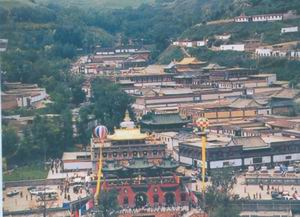Tsongkhapa (1357-1419), founder of the Gelug Sect
of Tibetan Buddhism, was born in today's Huangzhong County where
the Tar Monastery was founded.
The Ta'er Lamasery, a famous Tibetan Buddhist monastery in Qinghai
Province, was recently renovated, restoring it to its former glory.
Hoping to be the first worshippers to the lamasery after its renovation,
pilgrims of different ethnic groups came from near and far. Some
of them, in ethnic clothes and ornaments, carried abundant packages
of offerings; some rotated a prayer wheel in their hands while chanting;
and some lay flat or knelt on the ground, praying for the happiness
and well-being of their families.
Standing in an imposing manner according to the gradient of the
mountain, the Ta'er Lamasery is a wonderful architectural complex
that embraces 9,300 structures, including scripture halls, Buddha
halls, lamas' residences, and Buddhist pagodas. Built in 1622,
in the center of the entire complex, the Great Hall of Gold Tiles
is the core structure of the lamasery. The ridges of the hall's
roof are decorated with auspicious objects such as treasure bottles,
gold streamers, and gold deer. In the center of the hall is a
silver pagoda built around a pipal tree; and a statue of Tsongkhapa,
the founder of the Yellow Sect of Tibetan Buddhism, is placed
in the pagoda. In the hall there also exists a collection of hundreds
of works by Tsongkhapa and his disciples as well as hand-written
copies of scriptures in Tibetan and Mongolian. 
Tsongkhapa was born in Tsongkha (Tsong-kha), Amdo, in 1357, the
fourth of six sons. The day after Tsongkhapa’s birth, Chojey Dondrub-rinchen
sent his main disciple to the parents with gifts, a statue, and
a letter. A sandlewood tree grew from the spot where his umbilical
cord fell to the ground. Each leaf had a natural picture of the
Buddha Sinhanada (Sangs-rgyas Seng-ge sgra), and was thus called
Kumbum (sKu-‘bum), a hundred thousand body images. The Gelug monastery
called Kumbum was later built on that spot.
During this time, Chojey Dondrub-rinchen gave the boy the empowerments
of Five-Deity Chakrasamvara), Hevajra, Yamantaka, and Vajrapani.
By the age of seven, he had already memorized their complete rituals,
had completed the Chakrasamvara retreat, was already doing the
self-initiation, and already had a vision of Vajrapani. He frequently
dreamt of Atisha, which was a sign that he would correct misunderstandings
of the Dharma in Tibet and restore its purity, combining sutra
and tantra, as Atisha had done.
At the age of seven, Tsongkhapa received novice vows from Chojey
Dondrub-rinchen and the ordination name Lozang-dragpa. He continued
to study in Amdo with this lama until he was sixteen, at which
time he went to U-tsang (Central Tibet) to study further. He never
returned to his homeland. Chojey Dondrub-rinchen remained in Amdo,
where he founded Jakyung Monastery to the south of Kumbum.
The Gelug monastery and Jakyung Monastery are the two ancient
buildings of Ta’er Lamasery complex. In 1577, Maitreya Buddha
Hall was founded. In 1584, 1594, 1606 and 1626, Panchen Palace,
Tsongkhapa Hall, Sutra Hall, and Manjusri Bodhisattva Hall were
respectively founded. And they have formed today’s Ta’er Lamasery.
Ta’er Lamasery is the birth place of Gelug sect of Buddhism. Worshippers
and pilgrims of different ethnic groups came from near and far.
Some of them, in ethnic clothes and ornaments, carried abundant
packages of offerings; some rotated a prayer wheel in their hands
while chanting; and some lay flat or knelt on the ground, praying
for the happiness and well-being of their families. Ta’er Lamasery
has played an important role in Chinese Buddhist history and is
famous all over east Asia. It the treasure house of Buddhism and
is also valuable for studying politics, economics and culture
of Ming and Qing Dynasty.
|



